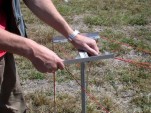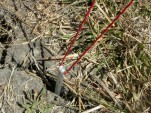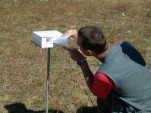|
Modulus
· MTO
· Nikon
· SONY
Measuring modulus
During the eclipse we measured exposure and temperature by in advance constructed modulus, which designed and
made Jiøí Hofman and Václav Šváb from the West-Bohemian affiliate of the Czech Astronomical Society. The same modulus used the second expedition in
Angola headed by Dr. Markova from the Upice Astronomical Observatory.
|

|

|

|
 |
|
Fixing the pedestal
below the modulus |
Detail of the fixation
(fixative pin) |
David probes whether
the modulus is switched on |
Details of the modulus
(before the expedition) |
The whole measurement by modulus lasted four hours, therefrom one hour before partial phase and one hour after it. From the reference reason the same measurement was made one day before the
eclipse. The modulus was placed on the special pedestal, which produced Mr. Jaroslav Petrovicky from the workshop of the Department of Physics, FEE CTU, and it was situated one
meter above the ground level.
During the both measurements it was a sunny weather with mild wind. The
measurements were carried out on the grass University playground in Lusaka. The
environment was open in all directions. The measuring place had coordinates:
latitude -15° 23' 42", longitude 28°19' 37"
(average value from 30 minute measurements by GPS), and altitude 1263 m. Contacts: T1 - 11:41:34, T2 - 13:09:19, T3 - 13:12:33, T4 -
14:27:00 (all in UT).
| Modulus and measuring place parameters |
| Mass |
1.7 kg |
latitude |
15° 23' 42" |
| Height |
100 mm |
longitude |
28° 19' 37" |
| Width |
235 mm |
altitude |
1263 m n.m. |
| Deep |
218 mm |
T1 |
11:41:34 UT |
| Height above ground level |
1 m |
T2 |
13:09:19 UT |
| Weather |
sunny |
T3 |
13:12:33 UT |
| Wind |
mild, omni directional |
T4 |
14:27:00 UT |
Results
The temperature (red curve) varied in the range of 2.5°C
only. It is not surprising as the weather was sunny and the wind was mild and
omnidirectional. The observation place was at the University playground in an
open area. The exposure (blue curve) decreased gradually during the whole
measurement.
The situation rapidly changed during the eclipse. The
temperature varied in the range of 7.2°C and reached maximum at 2 p.m.
local time. At 3.20 p.m. (local time) the temperature reached minimum value
(17.8°C). It occurred 8 minutes after T3. The delay of the temperature minimum
after the exposure minimum was 11 minutes. This phenomenon might be
explained via the huge heat capacity of the land and the atmosphere. The
exposure begun to decrease about two minutes after T1 and between T1 and T2 it
decreased almost linearly. During the total phase the exposure decreased bellow
measured value (zero value in the graph). After T3 the exposure was increasing
but not to the original value before the eclipse because the evening was coming.
On this graph you can see the comparison of measured
temperatures during June 20 and 21. While in the first measurement the temperature
varied in the interval of 2.5°C (during 4 hours), during the eclipse it was 7.8°C.
Comparing exposure it is obvious that till T1 the curves are
nearly identical. The exposure decreases linearly between T2 and T3 during the
eclipse and after T3 begins to increase. However it doesn't reach the original
value. The comparison curve decreases monotony as the Sun moves on the sky.
In Angola the temperature depletion is much more evident. The
value 10.7°C is caused by longer duration of total phase in Angola. The
temperature in Angola during the measurement was much more higher because the
observation place was located only 11° south from the equator and furthermore
it was near the coast and only 186 meters above the sea level. In spite of
the sooner beginning of the eclipse, the temperature after the eclipse didn't
reached the value before T1.
On this graph you can see the comparison of the exposure
curves during the eclipse in Angola and Zambia. The slope of the curves between
T1 and T2 is nearly the same in both cases. After T3 there is rapid increase and
subsequent decrease of the exposure. It might be caused by the location of the
observational place (4° north of Lusaka location) and quicker sunset.
|

